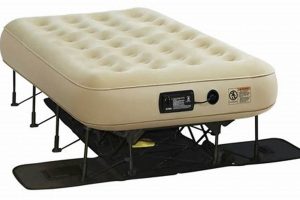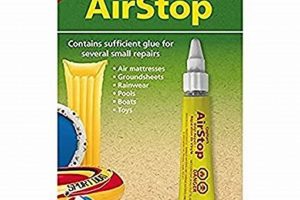Specialized support surfaces utilize interconnected air cells to redistribute pressure. These surfaces are frequently employed in healthcare settings to mitigate the risk of pressure injuries. The design allows for alternating inflation and deflation of individual cells, cyclically changing the points of contact between the patient and the support surface, thereby reducing sustained pressure on any single area.
The implementation of pressure-redistributing surfaces is vital in the prevention and management of pressure ulcers, contributing to improved patient outcomes and reduced healthcare costs. Historically, simpler solutions such as foam overlays were used, but the development of dynamic air cell technology represents a significant advancement in patient care, offering more effective pressure relief and enhanced comfort. The ability to adjust pressure levels further enhances individual patient comfort and optimizes pressure redistribution.
This article will delve into the specifications, operational principles, and maintenance protocols associated with these specialized support systems. Subsequent sections will cover clinical applications, best practices for implementation, and considerations for selecting appropriate systems based on patient needs and clinical environment.
Optimizing the Use of Air Support Surfaces in Hospitals
The correct implementation and maintenance of these specialized surfaces are critical to maximizing their therapeutic benefits and ensuring patient safety. These tips provide guidance on proper usage protocols.
Tip 1: Proper Inflation is Crucial: Ensure the surface is inflated to the manufacturer’s recommended pressure. Under-inflation can negate pressure redistribution benefits, while over-inflation can reduce patient comfort and increase the risk of skin breakdown. Verify pressure settings at regular intervals.
Tip 2: Select the Appropriate Mode: Understand the different operational modes. Alternating pressure mode is generally indicated for pressure ulcer prevention, while static mode may be preferred for patients who experience motion intolerance or those with certain medical conditions. Consult with clinical guidelines and patient assessment.
Tip 3: Conduct Regular Skin Assessments: Even with pressure-redistributing surfaces, frequent skin assessments are essential. Monitor bony prominences, such as the sacrum, heels, and trochanters, for signs of redness or breakdown. Early detection allows for prompt intervention and adjustments to care plans.
Tip 4: Ensure Compatibility with Bed Frames: Verify the surface is compatible with the hospital bed frame. Some surfaces may require specific frame attachments or support structures to function optimally. Incompatible pairings can compromise stability and effectiveness.
Tip 5: Implement Routine Cleaning and Disinfection: Follow manufacturer guidelines for cleaning and disinfection. Regular cleaning helps to prevent the spread of infection and maintain the integrity of the surface material. Use approved disinfectants and avoid harsh chemicals that may damage the air cells.
Tip 6: Provide Patient Education: Educate patients and their families on the purpose and function of the surface. Explain the importance of not placing items under the patient that could concentrate pressure and compromise the surface’s effectiveness.
Tip 7: Prevent Moisture Accumulation: Manage moisture to prevent skin maceration, which can increase the risk of pressure injury. Use moisture-wicking linens and incontinence management strategies as needed. Check and change linens frequently.
Adhering to these guidelines ensures the selected equipment operates effectively, contributing to improved patient comfort and reducing the incidence of pressure-related complications. Consistent attention to detail is paramount.
The concluding sections of this article will explore advanced features, troubleshooting common issues, and future innovations in this field.
1. Pressure Redistribution Efficacy
Pressure redistribution efficacy, in the context of air hospital mattresses, directly correlates to the mattress’s ability to minimize sustained pressure on bony prominences and other high-risk areas of a patient’s body. The functionality hinges on the alternating inflation and deflation of individual air cells, creating cyclical pressure changes that prevent prolonged ischemia and subsequent tissue damage. A mattress with poor pressure redistribution will fail to adequately offload pressure, rendering it ineffective in preventing pressure ulcers. Conversely, a system with high efficacy will demonstrably reduce the incidence of these complications, especially in immobile or high-risk patients. For instance, a patient with paraplegia confined to bed is highly susceptible to pressure injuries; an air hospital mattress engineered for optimal pressure redistribution is critical for their preventative care.
The design and material composition significantly influence this efficacy. Air cell configuration, inflation cycle duration, and the mattress’s ability to conform to the patient’s body contours are essential factors. Proper pressure mapping, using specialized sensors to measure pressure distribution across the surface, is a common method to validate and quantify pressure redistribution performance. The data from these tests guide design improvements and ensure the mattress meets stringent medical standards. Furthermore, the effectiveness can be augmented by integrating features such as low air loss therapy to manage skin moisture and further reduce the risk of pressure damage. The interface pressure levels achieved on the mattress dictates the extent of blood flow and reduction in the risk of tissue damage.
In summation, pressure redistribution efficacy is an indispensable performance attribute of air hospital mattresses. Deficiencies in this area directly compromise the mattress’s primary function: prevention of pressure injuries. Ongoing research and development focus on refining mattress design and incorporating advanced technologies to maximize pressure redistribution and ultimately improve patient outcomes. Understanding and prioritizing this characteristic is crucial for healthcare providers selecting appropriate support surfaces for at-risk patient populations.
2. Infection Control Protocols
The porous nature of some air hospital mattress materials and the potential for fluid ingress necessitate rigorous infection control protocols. Without proper adherence to cleaning and disinfection guidelines, these mattresses can become reservoirs for pathogens, leading to hospital-acquired infections (HAIs). The interconnectivity of air cells within the mattress can inadvertently facilitate the spread of contaminants. The absence of stringent protocols directly correlates with an increased risk of
cross-contamination between patients. For instance, inadequate disinfection after treating a patient with a known Clostridium difficile infection could result in the subsequent transmission of spores to other vulnerable individuals.
Effective infection control protocols typically involve several key steps. Manufacturers’ guidelines for cleaning and disinfection must be strictly followed, including recommended cleaning agents, contact times, and personal protective equipment (PPE) requirements for staff. Visual inspection for damage or compromised areas in the mattress’s surface is also vital; any breaches in the protective layer can allow for fluid penetration and harborage of microorganisms. Routine microbiological testing of mattress surfaces may be employed in some facilities to monitor the efficacy of cleaning procedures and identify potential areas of concern. Furthermore, some facilities employ disposable mattress covers to provide an additional barrier against contamination; however, this does not negate the need for thorough disinfection of the underlying mattress surface.
In summary, infection control protocols are an indispensable component of the safe and effective use of air hospital mattresses. Neglecting these protocols can have severe consequences, contributing to increased HAI rates, prolonged hospital stays, and elevated healthcare costs. Continuous staff training, meticulous adherence to established guidelines, and regular monitoring of cleaning efficacy are essential to mitigating the infectious risks associated with these specialized support surfaces and safeguarding patient well-being. The implementation of advanced technologies, such as antimicrobial mattress surfaces, further enhances infection control efforts but does not replace the need for comprehensive protocols.
3. Patient Comfort Enhancement
Patient comfort enhancement, when integrated with air hospital mattresses, plays a pivotal role in overall patient well-being and recovery. These mattresses aim to alleviate discomfort often associated with prolonged bed rest or limited mobility. The customizable nature of air pressure within individual cells allows healthcare providers to tailor the support surface to a patient’s specific needs and body contours. The consequence is reduced pressure points, minimized friction, and increased blood circulation, all contributing to a more comfortable and restful experience. Without prioritizing comfort, the therapeutic benefits of pressure redistribution may be undermined, as patients experiencing pain or discomfort may become agitated, hindering their recovery progress. A real-life example includes postoperative patients, where comfort directly influences pain management and reduces reliance on analgesic medications. A well-designed air hospital mattress contributes to a more therapeutic environment and ultimately impacts a patient’s healing trajectory.
Practical application of comfort-focused air hospital mattresses extends beyond simply providing a softer surface. Integrated features like low-air-loss technology, designed to wick away moisture and regulate temperature, further enhance comfort by minimizing skin irritation and promoting a more stable microclimate around the patient. The materials used in construction also play a significant role, with breathable fabrics and hypoallergenic components chosen to reduce the risk of allergic reactions and promote a more comfortable sleep environment. Adjustability features, allowing patients or caregivers to fine-tune the mattress’s firmness, contribute to a sense of control and autonomy, empowering patients in their own care. Therefore, a focus on comfort is not merely an ancillary benefit but an integral part of the therapeutic efficacy of these devices.
In conclusion, the symbiotic relationship between patient comfort enhancement and air hospital mattresses is undeniable. While pressure redistribution addresses physiological needs, the emphasis on comfort directly impacts psychological well-being and contributes to improved patient adherence to treatment protocols. The challenges lie in developing mattresses that effectively balance pressure relief with individual comfort preferences, requiring ongoing research and development in materials science and biomechanics. Ultimately, optimizing patient comfort translates to enhanced recovery rates, reduced hospital stays, and improved overall patient satisfaction. By prioritizing comfort as an integral design component, air hospital mattresses serve as a valuable tool in holistic patient care.
4. Durability and Longevity
The durability and longevity of air hospital mattresses are critical factors influencing their cost-effectiveness and long-term value proposition. Frequent replacement of these mattresses, due to material degradation or mechanical failure, leads to increased expenditure for healthcare facilities. The materials used in the construction of the mattress, including the air cells, outer cover, and any integrated electronic components, directly impact its lifespan. For instance, cheaper materials may be susceptible to punctures, tears, or chemical degradation from cleaning agents, thus shortening the mattress’s functional life. Conversely, mattresses constructed from high-quality, medical-grade materials can withstand the rigors of daily use and frequent disinfection, extending their operational lifespan and reducing the frequency of replacements. A mattress failing prematurely necessitates unexpected capital expenditure.
The design and engineering of the air mattress also significantly contribute to its durability. Reinforced seams, robust air cell construction, and protective coatings enhance the mattress’s resistance to wear and tear. Regular maintenance, adhering to manufacturer guidelines for cleaning and storage, further prolongs the mattress’s lifespan. Examples of inadequate maintenance include using abrasive cleaners that damage the surface material or improper storage that exposes the mattress to extreme temperatures or physical stress. The performance of internal air pumps and control systems is also crucial; malfunctions in these components can render the mattress unusable, regardless of the condition of the mattress itself. Consequently, a comprehensive assessment of durability should include evaluating the quality of all constituent parts, not solely the outer surface.
In summary, prioritizing durability and longevity when selecting air hospital mattresses is essential for effective resource management and sustained quality of care. While initial cost may be a factor, the long-term financial benefits of a durable mattress outweigh the savings associated with cheaper, lower-quality alternatives. Challenges remain in balancing cost considerations with performance requirements, necessitating careful evaluation of manufacturer specifications, warranty provisions, and user feedback. Ultimately, investing in air hospital mattresses designed for long-term durability contributes to a more sustainable and efficient healthcare system.
5. Operational Cost Considerations
Operational cost considerations constitute a significant aspect of air hospital mattress selection and management. The initial purchase price rep
resents only a fraction of the total cost of ownership. Energy consumption for inflation and pressure adjustment, repair and maintenance expenses, and the potential for reduced labor costs associated with pressure ulcer prevention directly impact the long-term financial implications. The selection of a less expensive mattress may initially appear advantageous, but frequent repairs, higher energy usage, or a reduced lifespan can ultimately lead to greater overall expenditure. For instance, a hospital that purchases a low-cost air mattress may experience increased maintenance frequency, resulting in significant downtime and additional expenses for repair services. Conversely, a higher-quality, energy-efficient model, while initially more expensive, can demonstrate superior cost-effectiveness over its lifespan through reduced energy consumption and lower maintenance requirements.
The impact of operational cost considerations extends beyond direct financial outlays. Reduced incidence of pressure ulcers, attributable to effective pressure redistribution provided by the mattress, can lead to decreased expenses related to wound care, shorter patient hospital stays, and reduced risk of litigation. Staff training on proper usage and maintenance protocols is a necessary investment to optimize the mattress’s lifespan and minimize repair costs. Furthermore, the environmental impact of disposal and replacement should be considered. Choosing mattresses with recyclable components or those designed for refurbishment can contribute to a more sustainable operational model, indirectly impacting cost considerations through potential rebates or reduced waste disposal fees. A holistic cost analysis incorporates the direct and indirect costs associated with the product throughout its entire lifecycle.
In conclusion, operational cost considerations are inextricably linked to the long-term value proposition of air hospital mattresses. A comprehensive understanding of these factors, including energy consumption, maintenance requirements, and the potential for cost savings through pressure ulcer prevention, is essential for making informed purchasing decisions. Prioritizing mattresses with lower operational costs, even at a higher initial investment, can lead to significant long-term savings and contribute to a more efficient and sustainable healthcare system. Challenges lie in accurately predicting maintenance costs and quantifying the benefits of pressure ulcer prevention, necessitating careful analysis of manufacturer specifications, warranty terms, and clinical outcomes data.
Frequently Asked Questions
This section addresses common inquiries regarding the use, maintenance, and selection of air hospital mattresses, providing concise and informative answers based on industry standards and clinical best practices.
Question 1: What is the expected lifespan of an air hospital mattress?
The lifespan of an air hospital mattress varies depending on several factors, including the quality of materials, frequency of use, and adherence to maintenance protocols. Generally, a well-maintained air hospital mattress can last between 5 to 7 years. However, regular inspections for wear and tear are essential to ensure optimal performance and patient safety.
Question 2: How often should an air hospital mattress be cleaned and disinfected?
Air hospital mattresses should be cleaned and disinfected between each patient use and on a routine basis, typically weekly or bi-weekly, depending on facility protocols and patient turnover. Adherence to manufacturer guidelines for cleaning and disinfection is crucial to prevent the spread of infection. The mattress must be fully dried before reuse.
Question 3: What is the maximum weight capacity for most air hospital mattresses?
The weight capacity of air hospital mattresses varies by model. Most standard air hospital mattresses have a weight capacity ranging from 300 to 500 pounds. Exceeding the specified weight capacity can compromise the mattress’s pressure redistribution capabilities and potentially damage the air cells.
Question 4: What are the common causes of air leaks in air hospital mattresses?
Common causes of air leaks include punctures from sharp objects, wear and tear at seams, and degradation of air cell material due to age or exposure to harsh chemicals. Regular inspection and prompt repair of any detected leaks are essential to maintain optimal pressure redistribution.
Question 5: How does an alternating pressure air hospital mattress function?
An alternating pressure air hospital mattress utilizes a pump system to cyclically inflate and deflate individual air cells. This alternating pressure redistributes weight and reduces sustained pressure on bony prominences, helping to prevent pressure ulcers. The cycle time and pressure levels are typically adjustable to meet individual patient needs.
Question 6: What type of patients benefit most from an air hospital mattress?
Patients at high risk for pressure ulcers, including those with limited mobility, impaired sensory perception, incontinence, or poor nutritional status, benefit most from air hospital mattresses. These mattresses are also beneficial for patients recovering from surgery or those requiring prolonged bed rest.
In summary, understanding the proper use, maintenance, and capabilities of air hospital mattresses is essential for maximizing their therapeutic benefits and ensuring patient safety. Following manufacturer guidelines and adhering to clinical best practices is paramount.
The following sections will delve into troubleshooting common issues and emerging technologies in the field of air hospital mattress design.
Conclusion
The preceding discussion has illuminated the multifaceted aspects of the air hospital mattress, from its functional principles and maintenance protocols to its crucial role in pressure ulcer prevention and patient comfort. A thorough understanding of these support surfaces, including their pressure redistribution efficacy, infection control requirements, durability considerations, and operational costs, is paramount for informed decision-making within healthcare settings. The appropriate selection and implementation of such systems directly impacts patient outcomes and resource allocation.
Continued vigilance and ongoing research are essential to optimize the design and application of air hospital mattresses. Healthcare professionals are urged to prioritize evidence-based practices and to remain abreast of advancements in this field to ensure the delivery of the highest standard of care. The proactive implementation of these strategies is critical in mitigating the risk of pressure injuries and improving the overall well-being of patients requiring extended periods of bed rest.




![Best Air Mattress Alternative [Top Picks!] Organic & Natural Mattress Buyer’s Guide: Non-Toxic Sleep Solutions Best Air Mattress Alternative [Top Picks!] | Organic & Natural Mattress Buyer’s Guide: Non-Toxic Sleep Solutions](https://mattressworldpa.com/wp-content/uploads/2025/07/th-6618-300x200.jpg)


